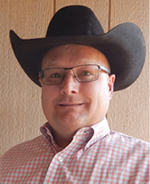Locoweed Poisoning of Horses
Guide B-713
Revised by Jason L. Turner and Chris Allison
College of Agricultural, Consumer and Environmental Sciences, New Mexico State University.
Authors: Respectively, Professor/Extension Horse Specialist, Department of Extension Animal Sciences and Natural Resources, New Mexico State University; Rangeland Scientist, Linebery Policy Center for Natural Resource Management, New Mexico State University. (Print-Friendly PDF)
Introduction
Locoweed has been reported to be the most widespread poisonous plant problem in the Western United States. It has a substantial economic impact and may be responsible for the loss of more than $300 million in annual income due to the deaths of poisoned livestock. The major contributors to these poisonings are plants from the Astragalus (Photo 1) and Oxytropis (Photo 2) genera, commonly called locoweed or milkvetch. Since there are over 300 species of these plants found across the United States, this publication will not discuss the identification, distribution, or habitat of locoweeds; readers should refer to Circular 557, A Guide to the Common Locoweeds and Milkvetches of New Mexico (http://aces.nmsu.edu/pubs/_circulars/CR-557.pdf), for such information. Instead, this guide will focus on the toxicity found in horses.
Toxic Principles
Swainsonine, an indolizidine alkaloid, is the toxic principle responsible for the pathological changes in body tissues that lead to the disease known as locoism. All parts of the toxic plants (seeds, flowers, foliage, and even pollen) contain some level of swainsonine, and it has been reported that dried plant stems retain sufficient swainsonine content to pose serious health risks even after a year or longer. There is a wide variety of swainsonine concentrations among all the different species and varieties of locoweeds, and this makes it difficult to ascribe any standard level of toxicity potential to a single species. This may be because swainsonine is produced by endophytic fungi growing within the plant. Comprehensive analyses in the United States, as well as in several other countries, show these endophytes in locoweeds belong to a new genus, Undifilum.

Photo 1. Dried and green rattleweed (Astragalus allochrous A. Gray) showing characteristic purple flowers, inflated pods, and leaves. Note: Purple flowers appear blue when dried.

Photo 2. White locoweed (Oxytropis sericea Nuttall). Note: Similarity of flowers and leaves to Astragalus.
Pathology of Locoism
Swainsonine inhibits certain cellular enzymes, which causes the accumulation of sugars within the lysosomes (cellular organelles that digest intracellular waste products). This inhibition increases the size and total number of the lysosomes within affected cells, which causes the formation of vacuoles (fluid-filled cavities) within the cell that disrupt normal cellular function. From a diagnostic perspective, the presence of such vacuoles in white blood cells may be indicative of acute exposure (within 48 hours) to swainsonine. In contrast, vacuoles in brain and neural tissue, endocrine glands, viscera, and reproductive organs occur with more extensive or chronic exposure.
The threshold dosage at which clinical signs of locoism appear is considered 0.3 mg of swainsonine per kilogram of animal body weight (e.g., 150 mg for a 1,100-lb horse). Since swainsonine is water-soluble, it is rapidly absorbed and excreted from the animal’s body via urine or milk in the case of lactating females. The serum half-life of swainsonine is less than 24 hours, so serum samples can only be used to diagnose animals currently grazing contaminated pastures and not those removed from suspect pastures. The typical blood profile of an affected animal would have detectable levels of swainsonine, decreased α-D-mannosidase activity, and increased aspartate aminotransferase (AST). Even though the vacuolar lesions present in many body tissues may diminish over time once the animal is removed from locoweed-infested forage, the damage done to brain and neural tissues is permanent and responsible for the abnormal behavior, incoordination, and impaired sensory perception that is characteristic of locoed animals. There is no proven effective treatment for locoism in horses, and locoed horses have a very poor prognosis for recovery.
Clinical Signs of Locoism
Since the formation of lysosomal vacuoles can be widespread throughout body tissues, the observable effects of locoism depend on the cumulative amount of toxin ingested and the specific tissue affected. While overall poor performance, decreased fertility, and deformed fetuses can be attributed to locoism, the classic symptoms of locoism are due to its effects on the nervous system. Horses appear more susceptible to locoweed’s neurotoxic effects, and horses typically display more distinctive signs than cattle or sheep.
Clinical symptoms of horses in the early stages of locoism include severe depression and lethargy, where the horse acts sleepy or stands very still. Once the threshold dosage of toxin is ingested, more pronounced symptoms may appear. These include:
- Weight loss.
- Odd or erratic behavior, including overreaction to various stimuli, such that the horse, when handled, may be severely head shy and rear and flip over backward or exhibit other violent and dangerous behaviors.
- Other neurological deficits include ataxia (loss of control of body movements), incoordination, head bobbing, or an exaggerated high-stepping gait.
Role of Grazing Behavior in Onset of Toxicity
One of the few research trials involving horses (Pfister et al., 2003) compared locoweed consumption patterns in cattle and horses grazing eastern Arizona rangelands infested with spotted locoweed during the spring (April to June). This study revealed several important facts about horses grazing locoweed:
- Horses were observed to begin eating locoweed on the second day of the experiment.
- Throughout the 47-day study, locoweed was shown to be a good nutrient source, averaging 30.4% neutral detergent fiber and 18.4% crude protein. Horses ate more green vegetation (grass and locoweed) than cattle, which were more likely to consume dry grass or other forbs early in the grazing season. This preference for grazing green vegetation is important when considering methods to avert horses from grazing locoweed (i.e., providing other green forage may reduce the likelihood that horses will consume locoweed).
- Horses began grazing locoweed earlier in the grazing season than cows, and the consumption of locoweed by horses increased over time more so than cattle. This is most likely because animals that continue to graze on locoweed develop habituation, or a psychological “need” for swainsonine, that causes them to seek out and consume locoweed more readily.
- Serum swainsonine levels in the horses mirrored the pattern of locoweed consumption, where serum swainsonine concentration in horses increased earlier and remained more elevated throughout the grazing season than cattle.
- After two weeks of consuming locoweed, the horses began showing obvious signs of depression, and by the fifth week of the experiment, the horses were showing the classical neurological symptoms of locoism.
- Throughout the study, all the horses were severely poisoned and in very poor body condition. After the grazing period, two of the horses were euthanized, and a necropsy of each was performed to evaluate the effects on various body tissues. The remaining two horses were removed from the locoweed and allowed to recover for 27 days before being euthanized for the collection of tissue samples. This “recovery period” had no favorable impact in terms of the damage already done to the horses' neurological tissues.
Management
Based upon the limited research involving horses, horses seem more likely than cattle to seek out the green vegetation provided by locoweed when other forage sources are dormant and less palatable. This does not rule out the possibility of locoweed poisoning of horses that ingest dormant locoweeds outside the growing season when other suitable forage may be sparse. Furthermore, the neurotoxic effects of swainsonine make affected horses a serious safety risk for humans working with them. Therefore, the only safe grazing recommendation is to ensure that “horse pastures” are free of locoweed. Previous work at NMSU has identified effective herbicide control strategies for locoweed, and these recommendations are available in Guide B-823, Locoweed Control: Aerial Application or Ground Broadcast (http://aces.nmsu.edu/pubs/_b/B823.pdf).
Conclusions
While locoweed toxicity is important to all livestock owners where it is found, it appears that horses are more likely to consume toxic levels of swainsonine and suffer more pronounced symptoms. Given the more common and extensive interaction between horses and humans, “locoed” horses pose a substantial risk to humans due to the increased potential for unexpected and violent behavior. Therefore, it is important that owners routinely monitor their “horse pastures” for the presence of poisonous plants. If locoweed is a concern in your area, remove horses from the pasture and provide alternative forage sources until the locoweed can be eradicated.
References
Allison, C.D., J.L. Turner, and J.C. Wenzel. 2016. Poisonous plants of New Mexico rangelands [Circular 678]. Las Cruces: New Mexico State University Cooperative Extension Service. http://aces.nmsu.edu/pubs/_circulars/CR678_spgs_lwres.pdf
Burrows, G.E., and R.J. Tyrl. 2001. Toxic plants of North America. Ames: Iowa State University Press.
Fox III, W.E., K.W. Allred, and E.H. Roalson. 2010. A guide to the common locoweeds and milkvetches of New Mexico [Circular 557]. Las Cruces: New Mexico State University Cooperative Extension Service. http://aces.nmsu.edu/pubs/_circulars/CR557.pdf
Hart, C.R., T. Garland, C. Barr, B.B. Carpenter, and J.C. Reagor. 2003. Toxic plants of Texas [B-6105]. College Station: Texas Cooperative Extension Service.
Knight, A.P. 1995. Plant poisoning of horses. In L.D. Lewis (Ed.), Equine clinical nutrition: Feeding and care (pp. 464–466). Philadelphia: Williams and Wilkins.
McDaniel, K., K. Duncan, and D. Graham. 2015. Locoweed control: Aerial application or ground broadcast [Guide B-823]. Las Cruces: New Mexico State University Cooperative Extension Service. http://aces.nmsu.edu/pubs/_b/B823.pdf
Pfister, J.A., B.L. Stegelmeier, D.R. Gardner, and L.F. James. 2003. Grazing of spotted locoweed (Astragalus lentiginosus) by cattle and horses in Arizona. Journal of Animal Science, 81, 2,285–2,293.
Pfister, J.A., B.L. Stegelmeier, C.D. Cheney, and D.R. Gardner. 2007. Effect of previous locoweed (Astragalus and Oxytropis species) intoxication on conditioned taste aversions in horses and sheep. Journal of Animal Science, 85, 1,836–1,841.
For further reading
B-709: Milkweed Poisoning of Horses
https://pubs.nmsu.edu/_b/B709/
B-710: Russian Knapweed and Yellow Star-thistle Poisoning of Horses
https://pubs.nmsu.edu/_b/B710/
B-712: Oleander Poisoning of Horses
https://pubs.nmsu.edu/_b/B712/
Original authors: Jason L. Turner, Extension Horse Specialist; Nick Ashcroft, Extension Range Specialist; and Sean Moore, Extension Agent, Colfax County.

Jason L. Turner is a Professor and Extension Horse Specialist at NMSU. He was active in 4-H and FFA while growing up in Northeastern Oklahoma. His M.S. and Ph.D. studies concentrated on equine reproduction, health, and management. His Extension programs focus on proper care and management of the horse for youth and adults.
To find more resources for your business, home, or family, visit the College of Agricultural, Consumer and Environmental Sciences on the World Wide Web at aces.nmsu.edu/pubs
Contents of publications may be freely reproduced for educational purposes. All other rights reserved. For permission to use publications for other purposes, contact pubs@nmsu.edu or the authors listed on the publication.
New Mexico State University is an equal opportunity/affirmative action employer and educator. NMSU and the U.S. Department of Agriculture cooperating.
Revised October 2023 Las Cruces, NM


